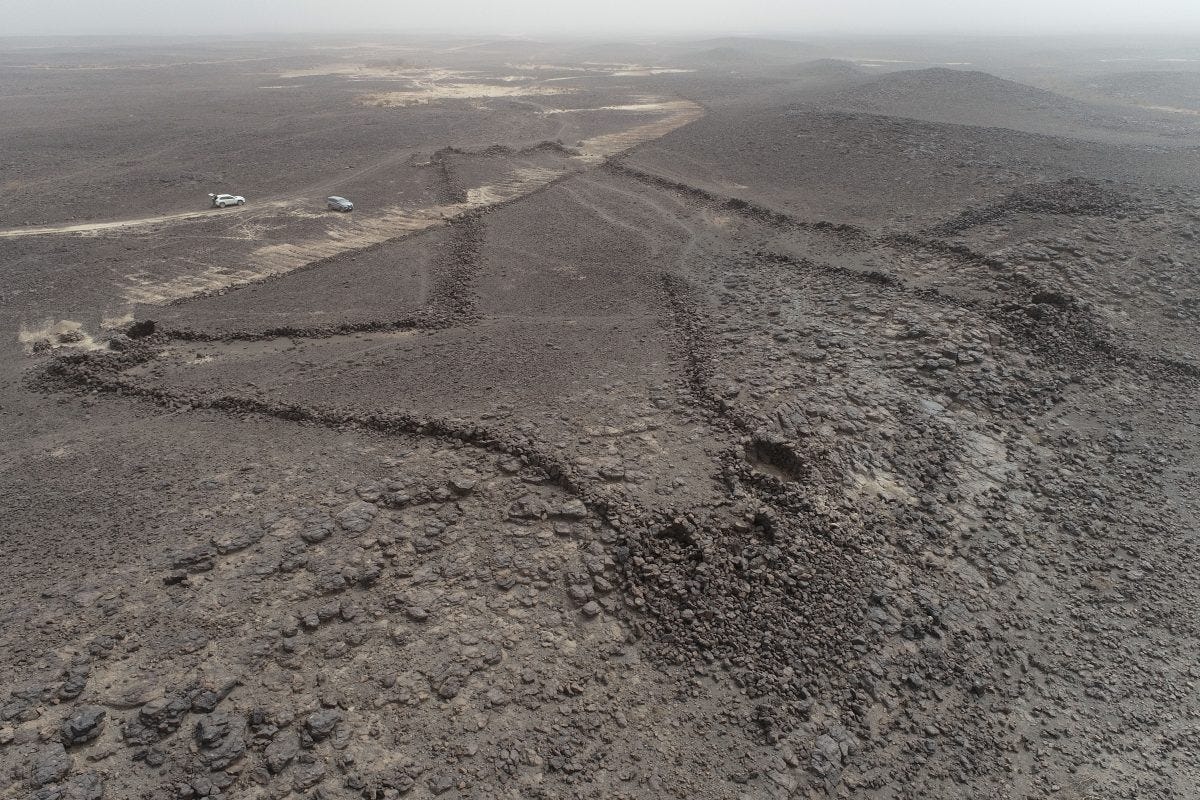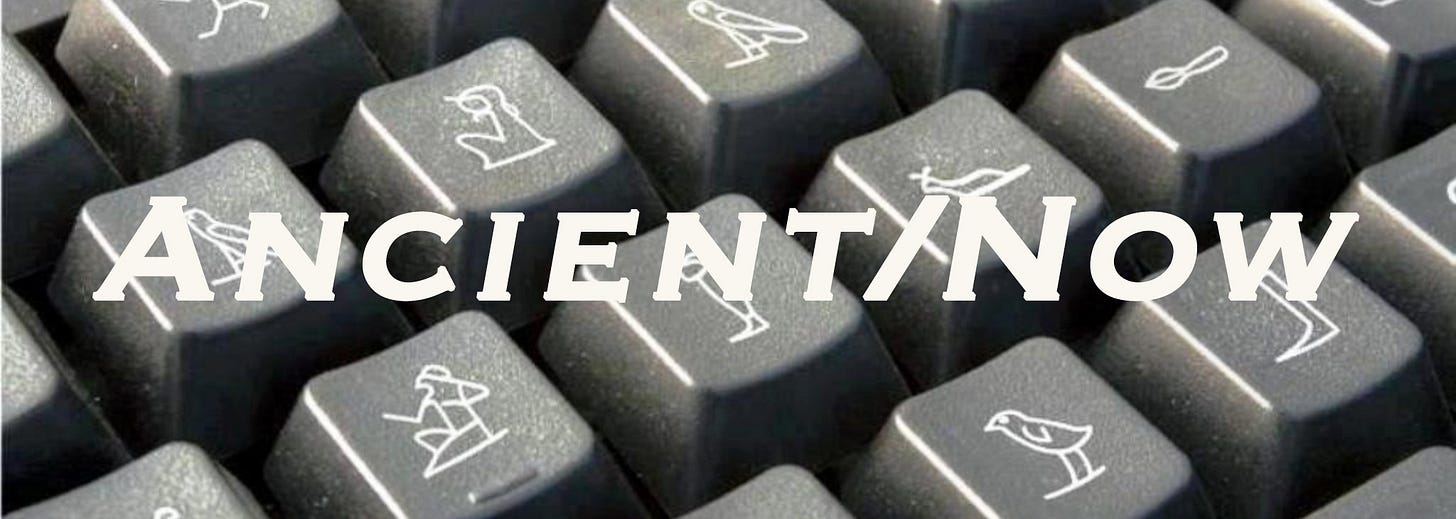Ancient/Now - May 30th
The mystery of ancient "desert kite" megastructures, the first sequenced human genome from Pompeii paves the way for further research, LACMA "abandons" art history in favor of contemporary art, & more
Unraveling the mystery of ancient megastructures known as “desert kites”

You want an ancient mystery? Well, here we go. The prehistoric megastructures known as “desert kites”—so called because from the air they resemble a kite with tail strings—have puzzled archaeologists over the past century, but a recent study in the Journal of World Prehistory sheds new light on the cultural and environmental context in which these desert kites were constructed. Most scholars now agree that the desert kites, found in desert areas of places like Armenia, Jordan, Kazakhstan, and Saudi Arabia, were constructed as trap-and-kill zones for herds of wild animals and played an integral role in the survival and subsistence strategies of ancient civilizations in these regions. New discoveries in Jordan and Saudi Arabia of apparent architectural plans for desert kites engraved in nearby stone monoliths suggest that these structures were well thought out projects to get scarce resources. The New York Times writes,
Dr. Crassard [archaeologist, French National Center for Scientific Research] and his colleagues were overjoyed in 2015 when they found two stone monoliths with precise depictions of nearby desert kites in Jordan and Saudi Arabia. Engraved between 7,000 and 9,000 years ago, these representations are by far the oldest known to-scale architectural plans recorded in human history, the team reported on Wednesday in the journal PLOS ONE. They also highlight how carefully planned the desert kites may have been by the ancient peoples who relied on them.
Other stone engravings that seemingly depict desert kites are known, but the new discoveries are unique in that they can be directly linked with specific kites on the ground, providing valuable insights into the history, function, and cultural significance of these ancient structures. Still, other questions persist:
What remains unknown is whether these depictions were prepared as blueprints to aid in the construction of the kites, or served as maps for hunters. The engravings could also be symbolic commemorations of the desert kites, which may have been an important part of the cultural identity of the ancient peoples who made and used them, said Wael Abu-Azizeh, an archaeologist with The French Institute of the Near East in Jordan and an author of the study.
It is unclear whether or not researchers will be able to answer such questions about desert kites—by definition prehistoric peoples did not leave written records—but experts continue to analyze satellite imagery and study the more than 6,000 desert kites that have been identified across the Middle East and western and central Asia.
First successfully sequenced human genome from Pompeii paves the way for future genetic analysis

You want ancient DNA? We got ancient Roman DNA, although we’re admittedly a little late to the party on this one. As highlighted by Smithsonian Magazine, last year Scientific Reports published a study of a bioarchaeolgical and paleogenomic analysis of two sets of human remains from Pompeii. The remains were those of a man and a woman found in the Casa del Fabbro, or House of the Craftsman, preserved in the eruption of Mt. Vesuvius in 79 CE. While the woman’s genome was not able to be fully sequenced, researchers succeeded in mapping the man’s genome. Prior to this study, experts were unsure as to whether or not ancient DNA could be extracted and sequenced from the human remains preserved at Pompeii. Now that a successful genomic analysis has been done, the way is paved for future studies to do the same:
“In the future, many more genomes from Pompeii can be studied,” she says. “The victims of Pompeii experienced a natural catastrophe, a thermal shock, and it was not known that you could preserve their genetic material. This study provides this confirmation, and that new technology on genetic analysis allows us to sequence genomes also on damaged material.”
Extracting ancient DNA is hella difficult! Don’t let anyone tell you any different (no matter how much they want to support nationalistic/identity agenda X or Y). Interestingly, it turns out that the Vesuvius eruption was actually helpful in preserving DNA:
Ironically, the way Pompeii’s residents died may actually have made their DNA more salvageable, the study’s authors assert. They say the pyroclastic materials produced during the volcanic explosion may have actually “shielded” bones “from environmental factors that degrade DNA.”
Pompeii has long been a treasure trove for archaeologists, and now that researchers know it’s possible to conduct bioarchaeolgical studies on the human remains preserved there, a new avenue for generating even greater insights into ancient life at Pompeii has been opened. We are all in favor of such ancient genome studies, as long as said DNA is not used to exclude those considered “foreign,” or claim state primacy, etc…
LA Times critic: Art history “abandoned” in favor of contemporary art at LACMA

“Do you miss LACMA? I do.” LA Times art critic Christopher Knight lamented this month in his piece, “Commentary: LACMA has transitioned to a de facto contemporary art museum. But not a very good one.” Established in 1961 as the Los Angeles County Museum of Art, LACMA was an art museum spin-off of the Los Angeles Museum of History, Science and Art (known today as the Natural History Museum of Los Angeles County), and in the past boasted being the largest encyclopedic art museum west of the Mississippi River. It is possible to trace 3,000 years of art history across the globe through LACMA’s vast art collection, but over the past decade the historical aspects of the collection have been subsumed by contemporary art. As Knight writes,
LACMA has transitioned into a de facto museum of contemporary art…How lopsided has the program been? Of the 11 shows on view at the museum last year, just two centered on historical art. The other nine — 82% of the program — presented art of the modern era…The old LACMA, on the other hand, was a rarity. With nearly 149,000 global objects still in a permanent collection that starts in ancient cultures like China’s Eastern Zhou dynasty and Olmec-era Mexico, LACMA is the premier encyclopedic art collection in Los Angeles. In fact, it’s the only one. Indeed, it’s the only one not just in Southern California but in all of the western United States.
To better understand LACMA’s turn away from traditional art history, one needs only to follow the money. Knight’s point that “contemporary art is where the big money and the blazing social spotlight are now” is well-taken, and he cites the Great Recession of 2007-08 and the changes it brought to the art market as contributing factors. But the museum’s trajectory toward contemporary art was apparent long before then. Billionaire Eli Broad, on a mission to make LA a center for contemporary art, exerted a great deal of influence at LACMA—not only as a wealthy patron, but because the museum was interested in acquiring his massive contemporary art collection. (Broad’s collection did indeed end up at LACMA, and now serves as the foundation for the collection of the Broad Contemporary Art Museum there.)
One might argue that focusing on contemporary art might be in part LACMA’s response to the complications of acquiring historical art and artifacts via the art market and issues of cultural repatriation, but it’s a weak argument. Museums declare their philosophy and institutional intentions through their directors, and in 2006 LACMA hired Michael Govan—an artist, not an art historian—as director of the museum. (See also the J. Paul Getty Museum’s hiring of former director Jim Cuno, who made it clear that expanding the museum’s collection was his priority, and his subsequent deep cuts to the Getty’s professional education staff to free up money for acquisitions.) LACMA declared its intentions of prioritizing contemporary art long ago with its hire of Govan. Sadly, we have to sympathize with Knight: We do miss LACMA and all its historical art.
What else were we reading this week?
3,000 year-old Egyptian figurine sensationally unearthed in former SS hospital
What's the oldest known case of cancer in humans?
“Proto-Rams”: Piecing Together the Early History of Naval Ram Development
Using Google Earth Pro, Archaeologists Have Discovered Unusual Roman Military Camps in Saudi Arabia
7,000-year-old tomb in Oman holds dozens of prehistoric skeletons
DNA study shows migration patterns of ancient Mexican civilizations much more complex than expected
Copper artifacts reveal changing connections in prehistoric Europe
Research reveals longstanding cultural continuity at oldest occupied site in West Africa
Why Does America Have So Many Towns With Classical Names?
'Haphazard' burial of 400-year-old skeleton from Colonial Maryland points to tragic fate of 'indentured' teenager
Aztec Antichrist: A Performance of the Apocalypse
Oldest Nearly Complete Hebrew Bible Sells for $38.1 Million
One more thing…
Some of the runway displays during the inaugural Egypt Fashion Week this month took their inspiration from ancient Egyptian fashion, as was fitting for the “Past, Present, Future” theme. To see more ancient-inspired looks, check out their Instagram.
Modern Egyptian designers are re-appropriating their cultural heritage in an interesting way. The very fact that the opening night took place a museum space—surrounded by ancient artifacts—is very telling as well. Western fashion designers have been doing such things for decades (think the 2018 Chanel show at the MET), but this is the first Egyptian designed fashion show with such ancient inspiration—a great subversion of the narrative.








